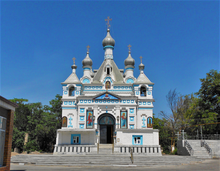Tashkent
Early history
Tashkent was settled by ancient people as an oasis on the Chirchik River, near the foothills of the West Tian Shan Mountains. In ancient times, this area contained Beitian, probably the summer "capital" of the Kangju confederacy.[2]History as Chach
In pre-Islamic and early Islamic times, the town and the province were known as Chach. The Shahnameh of Ferdowsi also refers to the city as Chach. Later the town came to be known as Chachkand/Chashkand, meaning "Chach City".[citation needed]The principality of Chach had a square citadel built here around the 5th to 3rd centuries BC, some 8 kilometres (5.0 mi) south of the Syr Darya River. By the 7th century AD, Chach had more than 30 towns and a network of over 50 canals, forming a trade center between the Sogdians and Turkic nomads. The Buddhist monk Xuánzàng 玄奘 (602/603? – 664 AD), who travelled from China to India through Central Asia, mentioned the name of the city as Zhěshí 赭時. The Chinese chronicles Suí shū 隋書 ("Book of Suí"), Běi shǐ 北史 ("History of Northern Dynasties") and Táng shū 唐書 ("Book of Táng"), mention a possession called Shí 石 or Zhěshí 赭時 with a capital of the same name since the fifth century AD [Bichurin, 1950. v. II].
In the early 8th century, the region was conquered by Muslim Arabs.
Islamic history
The modern Turkic name of Tashkent (City of Stone) comes from Kara-Khanid rule in the 10th century ("Tash" in Turkic languages means stone). After the 16th century, the name evolved from Chachkand/Chashkand to Tashkand. The modern spelling of "Tashkent" reflects Russian orthography and 20th-century Soviet influence.Mongol conquest and aftermath
The city was destroyed by Genghis Khan in 1219 and lost much of its population as a result of the Mongols' destruction of the Khwarezmid Empire in 1220. Under the Timurid and subsequent Shaybanid dynasties the city's population and culture gradually revived as a prominent strategic center of scholarship, commerce and trade along the Silk Road.Kokand khanate
In 1809, Tashkent was annexed to the Khanate of Kokand. At the time, Tashkent had a population of around 100,000 and was considered the richest city in Central Asia. It prospered greatly through trade with Russia, but chafed under Kokand’s high taxes. The Tashkent clergy also favored the clergy of Bukhara over that of Kokand. However, before the Emir of Bukhara could capitalize on this discontent, the Russian army arrived.Tsarist period
Alexander Nevsky Cathedral was built by the Russian Orthodox Church in Tashkent
In May, 1865, Mikhail Grigorevich Chernyayev (Cherniaev), acting against the direct orders of the tsar, and outnumbered at least 15-1, staged a daring night attack against a city with a wall 25 kilometres (16 mi) long with 11 gates and 30,000 defenders. While a small contingent staged a diversionary attack, the main force penetrated the walls, led by a Russian Orthodox priest armed only with a crucifix. Although defense was stiff, the Russians captured the city after two days of heavy fighting and the loss of only 25 dead as opposed to several thousand of the defenders (including Alimqul, the ruler of the Kokand Khanate). Chernyayev, dubbed the "Lion of Tashkent" by city elders, staged a "hearts-and-minds" campaign to win the population over. He abolished taxes for a year, rode unarmed through the streets and bazaars meeting common people, and appointed himself "Military Governor of Tashkent", recommending to Tsar Alexander II that the city be made an independent khanate under Russian protection.
The Tsar liberally rewarded Chernyayev and his men with medals and bonuses, but regarded the impulsive general as a "loose cannon", and soon replaced him with General Konstantin Petrovich von Kaufman. Far from being granted independence, Tashkent became the capital of the new territory of Russian Turkistan, with Kaufman as first Governor-General. A cantonment and Russian settlement were built across the Ankhor Canal from the old city, and Russian settlers and merchants poured in. Tashkent was a center of espionage in the Great Game rivalry between Russia and the United Kingdom over Central Asia. The Turkestan Military District was established as part of the military reforms of 1874. The Trans-Caspian Railway arrived in 1889, and the railway workers who built it settled in Tashkent as well, bringing with them the seeds of Bolshevik Revolution.
Effect of the Russian revolution
Tashkent ca.1910
The First Turkestan Muslim Conference was held in Tashkent 16–20 April 1917. Like the Muslim Council, it was dominated by the Jadid, Muslim reformers. A more conservative faction emerged in Tashkent centered around the Ulema. This faction proved more successful during the local elections of July 1917. They formed an alliance with Russian conservatives, while the Soviet became more radical. The Soviet attempt to seize power in September 1917 proved unsuccessful.[4]
In April 1918, Tashkent became the capital of the Turkestan Autonomous Soviet Socialist Republic (Turkestan ASSR). The new regime was threatened by White forces, basmachi; revolts from within, and purges ordered from Moscow. In 1930 Tashkent fell within the borders of the Uzbek SSR, and became the
capital of the Uzbek SSR, displacing Samarkand.
DONE BY NURSULTAN AMANGELDIEV 5A


No comments:
Post a Comment